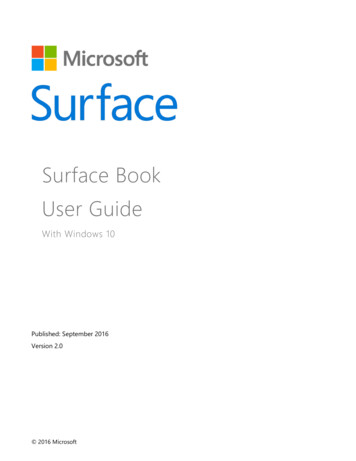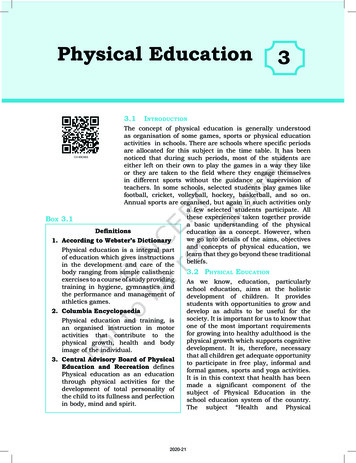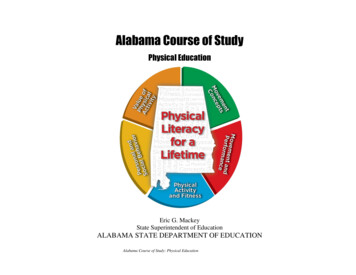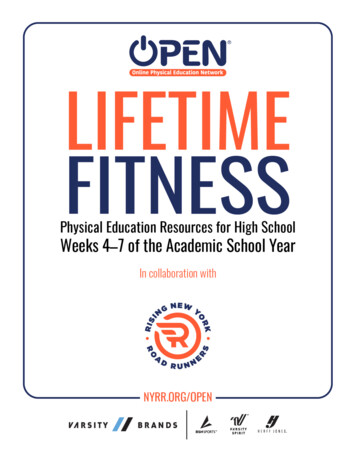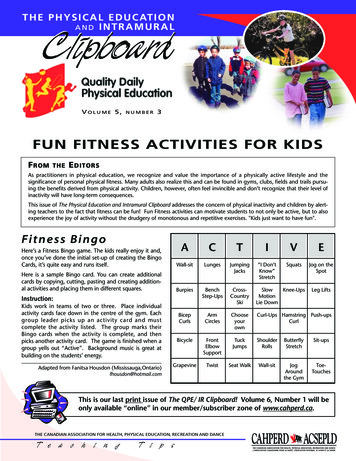
Transcription
T H E P H Y S I C A L E D U C AT I O NAND INTRAMURALClipboardVOLUME 5,NUMBER3FUN FITNESS ACTIVITIES FOR KIDSF ROMTHEE DITORSAs practitioners in physical education, we recognize and value the importance of a physically active lifestyle and thesignificance of personal physical fitness. Many adults also realize this and can be found in gyms, clubs, fields and trails pursuing the benefits derived from physical activity. Children, however, often feel invincible and don’t recognize that their level ofinactivity will have long-term consequences.This issue of The Physical Education and Intramural Clipboard addresses the concern of physical inactivity and children by alerting teachers to the fact that fitness can be fun! Fun Fitness activities can motivate students to not only be active, but to alsoexperience the joy of activity without the drudgery of monotonous and repetitive exercises. "Kids just want to have fun".Fi t n e s s B i n g oHere’s a Fitness Bingo game. The kids really enjoy it and,once you’ve done the initial set-up of creating the BingoCards, it’s quite easy and runs itself.ACTIVEWall-sitLunges“I Don’tKnow”StretchSquatsHere is a sample Bingo card. You can create additionalcards by copying, cutting, pasting and creating additional activities and placing them in different squares.JumpingJacksJog on -UpsMotionLie DownBicepCurlsArmCirclesChooseyourownCurl-Ups Hamstring derRollsButterflyStretchSit-upsGrapevineTwistSeat WalkWall-sitJogAroundthe GymToeTouchesInstruction:Kids work in teams of two or three. Place individualactivity cards face down in the centre of the gym. Eachgroup leader picks up an activity card and mustcomplete the activity listed. The group marks theirBingo cards when the activity is complete, and thenpicks another activity card. The game is finished when agroup yells out “Active”. Background music is great atbuilding on the students’ energy.Adapted from Fanitsa Housdon (Mississauga,Ontario)fhousdon@hotmail.comLeg LiftsThis is our last print issue of The QPE/ IR Clipboard! Volume 6, Number 1 will beonly available “online” in our member/subscriber zone of www.cahperd.ca.THE CANADIAN ASSOCIATION FOR HEALTH, PHYSICAL EDUCATION, RECREATION AND DANCET e a c h i n gT i p s
Developed and produced by Active Health Kids Canada, activ8 is a curriculum-basedphysical activity challenge program consisting of eight pre-planned lessons for gradesK-8. Each lesson includes warm-ups, cool-downs and fun physical activity challengesthat help students of all abilities develop their fitness and skill levels. Developed bycurriculum and child development experts, activ8’s pre-planned lessons are linked toprovincial curricula. To order your FREE copy of activ8 today,call 1-888-446-7432 or visit www.activ8.orgJumpandStickGrade 1 ChallengeWith the whole class, tella story while the studentsact it out. The story mayinclude a baseball game,track and field competition, fire rescue, buildingconstruction, hike, orfairy tale.Include a lot of actions inthe story that describejumping,bending,supporting, turning andtwisting.Optional equipment maybe added to suit thetheme; e.g., hulla hoopsrepresent puddles, benches represent rocks toclimb over.Encourage moves withone and two-foot hopsand jumps and solidlandings.SAMPLE STORY - SPROING’S STORYSay words that are bold loudly and watch for the students doing the actions.There once was a squirrel who loved to jump. This squirrel’sname was Sproing. Sproing did not scamper most of the timelike regular squirrels, but instead hopped and jumped andleaped everywhere she went. She woke up early every morning,stretched her arms, waved hello to the sun then scampereddown her tree to begin her day. She rarely went straight down thetree. She liked to jump from branch to branch first. She loved it when thebranch would bounce and she would have to try to keep her balance beforeleaping to the next branch.The first stop in Sproing’s day was almost always the park. She would find thebenches and climb up onto the seats. She would walk carefully along thebenches then jump off, making a safe landing. She would look under thebenches to see if she could find any food or treats to eat. Another one ofSproing’s favourite things to do was to run along the path in the park andjump high over every crack in the sidewalk. She liked to pretend that she wasa super flying squirrel, jumping as high as she could over every line shesaw. Sproing’s day went on like that with every activity involving jumping.She hopped over small things like leaves, she jumped over big things likerocks, she especially loved to jump over things that were in a row – likejumping from rock to rock in the river.Sproing’s day usually ended with a visit to the garden. She would jump fromflower bed to flower bed, sniffing the beautiful flowers, reaching up to touchthe tall sunflowers and crouching down to look at the tiny pieces of grass.Sproing was usually pretty tired at the end of the day. She liked to do a littlestretching in the garden before going home to her nest. She reached high tothe sky, stretched her paws out to both sides, stretched down and touchedher toes. She shook out her legs after all of her jumping, then headed homefor one leisurely climb into her tree. In her nest, she curled up, closed hereyes and went to sleep, dreaming of another day of jumping tomorrow.THE CANADIAN ASSOCIATION FOR HEALTH, PHYSICAL EDUCATION, RECREATION AND DANCET e a c h i n gT i p s
Traffic LightsElephants, Giraffesand Palm TreesELEPHANT – Shoulder on nose with armdangling to form the trunk. People oneither side hold extended palms to formelephant’s ears.GIRAFFE – Right hand up in a fist over thehead, head down.PALM TREE – Both arms up over the headswaying back and forth while makingnoise (whoooooh) like a breeze. Two otherstudents attach themselves to either sideof the first students’ hips to become sidepalm trees.The teacher works from the middle ofcircle. After explaining the three positions,the teacher points to a student (inrapid/random order) naming one of thethree positions. The student then assumesthat position. If the student (and partners)makes a mistake, they run around thecircle (or do pushups, sit-ups etc.) andreturn to their place.Submitted by: Karen Tsuji (Hamilton, Ontario)bkn@idirect.comGet on the computer and giveyour students a “CertiFITicate”for reaching their goals!!(K-3)Students run freely around the activity area:when RED is called – everyone stops;YELLOW –walk; GREEN – run. Add to thegame by having students perform balancesor stretches for RED, funny movements(hands over head waving, knees high etc.)for YELLOW, and zig-zag movements forGREEN. This is a good warm-up activity.Sc out ’s P ac e (3-5)This is an interval training activity. Select aroute (distance determined appropriate tostudents). Students start by practicing thepattern of running for 20 paces in a localizedarea and then walking for 20. Once theyunderstand the sequence, they can moveout onto the selected course or trail. Theidea is not to challenge one another, but tocomplete the distance without becomingout of breath.S huttle R un R ela y (K-3)Working in teams of two to three students,provide three bean bags to each team. Eachperson on the team takes a turn to runwhere all three bean bags are placed, picksup one and returns it to their starting point.Once all three bean bags have been collected, students take turns returning them to theoriginal position. The game is over wheneach player has had a turn and the team issitting quietly.Submitted by Garth Wade garth.wade@nbed.nb.ca
FUN FITNESS FOR KIGUARANTEEDS AT I S FA C T I O NThis warm-upgame is calledA Checklistfor Intramural SuccessFITNESS Promote the activity in advance –the more hype and hoopla thebetter.It follows a similar premise to the Monopoly board game. Offer incentives to participate. Forexample, the group with the mostparticipation receives special recognition.Materials:- A few pairs of dice (large size –can be found at your localdollar store)- Whistle- Laminated activity/exercisecards (to be posted around theperimeter of the gym on thewalls)- Laminated 200 dollar bills(with school logo or teammascot)- Creative GET OUT OF JAILstation card (example - theentire group must chant outone or more nursery rhymeswhile doing jumping jacks)Activity: Divide the class into groups of three or more. Each group is directed to adifferent square on the wall. That is where they must start. Examples ofsquares are: one minute wall sit, 25 push-ups, 50 step-ups, 30 tucks When the whistle is blown each group performs the task in their activitysquare and runs to the center of the gym. The dice are located here andit’s a good idea if someone like a peer-tutor or teacher monitors the rollsand accuracy of the next move on the Monopoly board. The group canonly roll when all the members are present in the middle of the gym. After the group rolls, the students run in a clockwise direction to theirnext square and the whole process starts over again. The object of the game is for each group to get around the board as fastas they can so they can pass Go and Collect 200. The group with themost money at the whistle (usually after 5 to 10 minutes) wins. It issuggested that either the teacher or peer-tutor issue the 200 each timethe group passes GO. This warm-up activity can be changed daily using different exercise tasksfor each square and incorporating different penalty scenarios located atcertain squares.Joanne Zizian (Niagara-on-the-Lake, Ontario) jbziz@becon.orgTHE CANADIAN ASSOCIATION FOR HEALTH, PHYSICAL EDUCATION, RECREATION AND DANCET e a c h i n gT i p s Complete a safety check of the playarea before the event. Where large numbers of participants are involved, place spottersthroughout the crowd to watch forpotential safety hazards. Involve teachers, principals, andother participants in the activity. Inform helpers and other leaders ofthe format of the activity. Effectivecommunication in advance willassist in the delivery of a successfulevent. Make sure that you can be heard.Use a PA system or megaphone ifnecessary. Repeat key instructions. Instructionsshould be clear and concise. Incorporate music into the activitywhenever possible. Break the ice with quick energizers. Take pictures and/or video. Displaythe photos after the event. Usethem to promote future events. Evaluate and make recommendations. Receive feedback from theparticipants whenever possible.
DS – INTRAMURALSAll Out SoccerPass Ball RunEquipment:Equipment:-- Gator Skin BallTen white Gator Skin ballsTen yellow Gator Skin ballsTwo large cardboard boxesFour large pylons and coloured pinniesDescription:- Divide participants into two teams. Have them standon the side of the playing area or gymnasium.- Set up cardboard boxes beside the goals. The goalsare six feet wide and two feet high and can bemarked by tape.- Each team can only score a goal using their designated coloured balls.- Regular soccer rules apply except there are nogoalies (optional).- After a goal is scored, the player picks up the ball andplaces it in the cardboard box that is beside theiropponent’s goal.- The player who scored the goal then runs to theirhome box and removes one of their balls and playcontinues.- If there are no balls in the opponent’s cardboard box,the goal scorer must wait until another goal isscored.Description:Form a circle of six or seven participants.- The first player passes the ball to another player and soon until every player has touched the ball once and thelast player has passed it back to the first person. Be sureno one passes to the player beside them.- Once a pattern has been established, the players areready to begin the game, i.e., 1-4, 4-7, 7-3, 3-5, 5-2, 2-6and 6-1.- Player “one” makes a pass and then attempts to runaround the outside of the circle before player “six” getsthe ball and passes it back to “one”.- In order for everyone to get a turn, change the player inthe number “one” position frequently.Variations:- Have participants work on different passes, i.e., bounceor chest.- Have the runner dribble a ball around the circle.- Have the runner dribble to a basket, make a shot andreturn back while the players pass the ball three timesaround the circle.Great Gator Games - Awesome Asphalt Activities(CIRA - Ontario, available through CAHPERD)Thumb WrestlingCompetitors interlock their four fingers on their right or left handto make what looks like a first. Players lift their thumbs and touchthem to the left, right, left and right again as they say:“1, 2, 3, 4, I declare a thumb war”“Bow”Thumbs bow to each other“Face” Show the face of your thumb to your opponent’s thumb“Fight” Attempt to pin their thumb with your own thumbAwesome Asphalt Activities (CIRA-Ontario, available through CAHPERD)Great Gator Games - Awesome Asphalt Activities(CIRA - Ontario, available through CAHPERD)
TraditionalFour SquareFour players are needed for atraditional game of Four Square.Each person is assigned a square withthe goal of the game being to displacethe player from the number onesquare.The player in square one, who servesfrom the back corner of their square,puts the ball in play. The ball isdropped and hit with the open handinto one of the other squares. Theball may or may not bounce once inany square before the player in thatsquare hits the ball into anothersquare.Misses occur when a playerfails to hit the ball successfullyinto another square or hits it outof bounds. When a “miss” occurs,the person who is responsible goes tothe end of a challenge line and waits tore-enter the game. The other playersmove up one square and the firstperson in the challenge line moves tosquare four.VariationsVariations are endless depending onthe capabilities of the participants.Allow players to juggle or bounce theball before batting it, or to allow themto actually catch the ball and bounce itbefore hitting it.Awesome Asphalt Activities (CIRA-Ontario,available through CAHPERD)ImaginarySoccerEquipment:- minimum of 8 pylons to make 2 goals for each team (you canhave 12 pylons and make 3 goals each)- pinnies for one teamPlaying Area: Make a rectangular field with multiple goals onthe end line (start 30 x 20 and adjust).Players: This game is ideal for students 12 years and up. Itcan be played with a minimum of 2 vs 2 up to 10 vs 10.Rules:- When you are in possession of the imaginary ball you must haveyour arm extended up so everyone can see who has the ball.- To pass the ball to a teammate you must call his/her name. Whenthe teammate receives the ball, he or she puts an arm up toindicate possession. (For an icebreaker and learning names activity,you can also have the receiver say “Fred’s ball”).- To score, a ball carrier runs through any of their designated goals.- To gain the ball, the opponent tags the ball carrier (arm is up).Immediately after tagging, the tagger becomes the ball carrier andshould have his or her arm up.Principles: Creating space, marking up, communication, looking forthe open goal and open player. The benefit of this game is thatteam play can be practiced with the ball skill of the individualplayers neutralized.Submitted by: John Byl byl@redeemer.on.caTHE CANADIAN ASSOCIATION FOR HEALTH, PHYSICAL EDUCATION, RECREATION AND DANCET e a c h i n gT i p s
BottleballHere’s a great game for students orcampers who have been “bottled”up all day. The activity promotesphysical activity and friendly competition in a nonelimination format.Equipment:- A ten inch gatorskinball(s)- one empty 2L pop bottleper player (If you’re short onpop bottles, pair off playersand add additional gatorballs.)“Bottleball” can be played in a gymnasium or on a playing field. Thenumber of participants varies based on the playing space. (e.g., smallgym under 50 players, large gym 50 , soccer pitch 100 )Each player finds a spot on the floor or field to place their bottle. Theobject of the game is to protect the bottle while trying to knock downthe opponent’s bottle with the gatorball. If your bottle is knocked over,the player does a penalty exercise and returns to the game. Suggestedpenalty activities include: rope skipping, bench stepping, sit ups, pushups and jumping jacks.Complementary Activities:Pop Bottle Drive – Ask the children to bring pop bottles from home anddonate the refundable deposit to a local charity or fundraising project.Good Guess – Fill a 2L pop bottle with marbles or macaroni. Who canguess the number of marbles/macaroni and how much they weigh?Mass Appeal - Awesome Asphalt Activities(CIRA-Ontario, available through CAHPERD)Circle BallEquipment:- 1 soccer ball- 1 Ping Pong Ball per team- 1 Skipping Rope per teamThis game is ideal for 10 ormore players.Divide the group into twoteams. Use the skipping ropesto make two circular goals ineither end of the playing area.Each team is given a Ping Pongball. The Soccer ball is placed inthe middle of the playing area.Each team in the game movesas a unit. If any member of theteam lets go or becomesseparated from the rest of thegroup, the team loses a point.On “GO”, each team moves itsPing Pong ball along theground and into the goal of theopposing team. Any player maytouch the ball. No player maytouch the ball twice in a row.As soon as a team “sinks” itsPing Pong ball, it races to thecenter to try to kick the soccerball into the opposing goal.The first team to do so scores apoint and the game is repeated. The team scoring the mostgoals with the soccer ball is thewinner.Clouds on the Clothesline and 200Other Great Games, J. Pearse,J. McCutcheon, B. Laughton(available through CAHPERD)
“ L uck of the D r a w ” F itness R ela y sPurpose:This is a general warm-up to prepare students for vigorous physical activity. It is especially geared to prepare physical education students for the fitness portion of the curriculum.Expectations:Materials Needed:- Students will put forth maximumeffort to complete the relay.-The entire gymnasiumA deck of regular playing cards- Students will enhance their fitnessskills in preparation for fitness testing.LISTENt o theKIDSChildrenhave cited anumber of perceivedbarriers to increasingtheir activity levels NO FUN. Too muchsupervision. Lack of skill andconfidence in ability. Don’t know what’savailable. No time. Don’t like theprograms that areoffered.- Students will demonstrate animprovement in skill level over time.Time:The activity takes about 10 minutes to complete;however it can be shortened or lengthened as per the instructors’ time constraints.Instructions: Divide the class into groups of three or four. Have each group line up in single file along the baseline at one end of the gymnasium. Show the top card from the deck. The number shown (i.e. eight) represents howmany push-ups, sit-ups, and jumping jacks the students must complete. You and yourclass can decide what face cards represent. My class has decided to use “jack” as 11,“queen” as 12, “king” as 13, and “joker” as one. The first student in each group must run 1/3 of the gym and then stop and do thenumber shown on the card in push-ups. When they have completed the push-ups, they run another 1/3 of the gym, stop, anddo the same number of sit-ups. Students then run to the end of the gym, stop, and do the same number of jumpingjacks. From there the students must run back to their line and stand in the last position. Repeat the whole procedure, showing a new card to the next student in line of eachgroup, until every student has had the opportunity to complete the relay five timesthrough.Assessment:Students can be assessed on two separate levels. The first level is based on attitude andwillingness to participate. The second level is based on competency in completing theactivity with skill and demonstrated improvement over time. Don’t know how toget involved.Cautions:Ask YOUR kids To prevent injury, demonstrate the proper technique for push-ups, sit-ups, and jumpingjacks before allowing the class to participate in the activity.Are there other barriers?Advancement:Can YOU eliminatesome of these barriers?When students become more proficient at the activity, consider adding extra challenges.For example, when a red card is pulled from the deck, the number shown must bedoubled (i.e. the eight of hearts now represents 16).Lara Weibe, Niagara District Secondary School lweibe12@yahoo.caTHE CANADIAN ASSOCIATION FOR HEALTH, PHYSICAL EDUCATION, RECREATION AND DANCET e a c h i n gT i p s
S ingle R op e Individual S k ippingC hallengesThe following challenges are designed for allages and abilities. Each participant needs anindividual skipping rope.Skill and Creative ChallengesAsk students to: Play “Copy Cats”. Skipper A shows askipping skill to Skipper B who tries tocopy it. Then Skipper B shows a skill toSkipper A who then tries to copy it. Skip for a prescribed amount of time(30-60 seconds) while performing skills. Determine how many (choose a skill e.g.,Front Crosses) can be performed in a rowwithout a miss. Perform a sequence of three skills in a rowwith no misses. Find different ways to turn the rope usingan arm action and a footwork action. Find different ways to jump the rope witharms in varying positions.L et ’s M ake a D ealThis is a fun fitness warm-up activity that gets the kids hootin’ andhollerin’ and hearts a-thumpin’.Quickie Version: Shuffle a deck of cards and make three equal stacks. The stacksrepresent the doors that the students will choose (Door #1, Door #2,or Door #3). The instructor calls out an exercise (e.g. push-ups, situps, etc.). Students choose their door by going to three areas in the gym (suchas basketball keys and center court circle). Each door/area has a corresponding stack of cards. After studentshave moved to their door/ area, the cards are turned over and thestudents perform the activity the number of times shown on thecard (If the card is a seven and the activity is sit-ups, they do sevensit-ups.) The activity continues as more activities are called out. Find different ways to jump backwards. Continue until all warm-up exercises are completed. Find different ways to change the ropedirection from forward to backwardsturning.Longer Version:Fitness ChallengesAsk students to: Perform forward jumps in a row. Counthow many you can do with no misses.Vary the activity with:- Backwards jumps- Jumps with arms crossed- Specify other skills Determine how many jumps can be donein 15 seconds (progressively add time asspeed increases). Jump for 60 seconds without stopping(progressively add time as enduranceincreases).Submitted by: Susan Kalbfleisch(Ancaster,Ontario) susan@jumprope.com Make up a series of cards with a variety of exercises and number ofrepetitions beforehand. Shuffle cards and put into three piles representing three differentdoors. Students choose a door and move to that area. Cards are turned over. To increase the fun, add some silly cards (i.e. twiddling yourthumbs).Herwig Baldauf, Niagara-on-the-Lake, Ontario wig@mergetel.com“ No one knows what they can do until they try.When it comes to physical activity, the onlylosers are the ones who don’t try.”
RFOIGHO TTKNEEMOVE YOUR BODY!This activity is suitable for any number of people and can beplayed just about anywhere. It is a great energizer to liven up any group.SHLDOUBELLYERTOESOWBELEquipment:- The game requires large cards with pictures or names of body parts marked in bright, bold colours.- Loud, upbeat music would definitely be an asset!FINGERSTo begin, the group leader flashes a card and everyone isinstructed to “move” or “shake” that body part. Cards continue to be shownuntil the participants are “all shook up”. Try flashing toe cards quickly to see the laughterand mayhem that follows!IRHACHINPlay:Introduce an added challenge by identifying a penalty body part. When that bodypart is shown, players must sit down. Whoever forgets and shakes that body partinstead, is eliminated. See which players stay in the game the longest!Complementary Activities:Skeletal Remains – On a diagram of a skeleton, name the parts of the body.Pin the Ear on the Skeleton – Pin the tail on the donkey with a twist!Target Exercises – Identify a specific body part and target an exercise for that part ofthe body. How about “nose push ups” – scrunching your nose up and down?Mission Impossible – Try to avoid using a certain body part for a day or a portion ofa day.Boney Relay – Divide teams into groups of ten. Using paper, make a lifesizeskeleton. Each skeleton should have 10 joinable parts. In a relay format, each teammember runs, picks up a body part and places it on the skeleton.Mass Appeal - Awesome Asphalt Activities (CIRA-Ontario, available through CAHPERD)Need MORE Ideas for Your Fun and Exciting Intramural Program?See the CAHPERD “Play Days” CLIPBOARD (Vol. 3, No1)or visit our e-bookstore.www.cahperd.caTHE CANADIAN ASSOCIATION FOR HEALTH, PHYSICAL EDUCATION, RECREATION AND DANCET e a c h i n gT i p s
“ It takes a lot less energyto be active with kidsthen it takes to controlkids who want to beactive.”Fruit SaladGrade 4 Warm UpSet-up:- Briefly discuss the importance andcontent of a nutritious snack andhow energy helps fuel the body.- Identify four or five teams bynaming students as bananas,oranges, mangos, grapes or othercreative choices chosen by thestudents. Each fruit group movesto one end of the gym, with twoor three students remaining in themiddle of the gym to act astaggers.- Active music should be played inthe backgroundActivity: Call out one or two fruit groups.Students attempt to travel fromone end of the gym to the otherwithout being tagged. If tagged,the fruit/student goes to a designated “fruit salad bowl” at the sideof the gym and moves to themusic. Randomly call “fruit salad!” and alltagged fruits run to the oppositewall and then back to their fruitgroup. Call “fruit salad” frequentlyso students keep moving. Restart the game often so studentsstart “fresh”.Conveyor BeltGrade 1 Cool DownThis activity is a unique way to have students put equipment away.Students put the equipment that was used (e.g., balls and hoops) ina pile.Students lie down with knees bent and arms stretched out over theirhead, forming a line that stretches from the equipment room doorto their pile of equipment.Students pretend to be a conveyor belt, moving their equipmentfrom their pile back to the equipment room. The student at the endof the line nearest the pile of equipment picks up a ball or a hoopfrom over their head, sits up, reaches forward and places it in thehands of the next student in line. That student sits up and carries theequipment forward to the next student in line. The students continue in this manner until all of the equipment has been transported tothe equipment room.April RainGrade 3 Cool DownIn scatter formation, students lie on the their backs with their handsby their sides and their shoes on.Instruct students to drum their heels on the floor to resemble thepattern of light, medium and heavy raindrops.Repeat the drumming action using cupped hands on the thighs forheavy rain, medium rain and light rain.Finish with silence.For more fun fitness activities, teachers can order their free copy ofactiv8. Call 1-888-446-7432 or visit www.activ8.orgSubmitted by: Karen Hood, Projects Leader, OPHEA karen@ophea.org
The mediocre teacher tells.The good teacher explains.The superior teacher demonstrates.The great teacher inspires.- Author UnknownC anada ’s P hy sic al A c tivit y G uide f or C hildr en and YouthThe Guide will help children:Increase time currently spent on physical activity, starting with 30 minutes more per day.Reduce “non-active” time spent on TV, video, computer games and surfing the internet, startingwith 30 minutes less per day.For More Information —STRENGTHall contribute to a healthy body. For best results all three types of activities should be combined andperformed regularly.Endurance activitiesmake you breathe deeper, your heart beat faster, and make you feel warm. They include activities such asrunning, jumping, skipping, skating and swimming. Endurance activities strengthen the heart and lungs.Flexibility activitieslike bending, stretching, twisting and reaching, keep your joints moving.Flexibility activities include gymnastics and dancing.Strength activitiesbuild your muscles and bones. Strength activities include climbingor swinging across the playground ladder.Canada’s Physical Activity Guide for Children and YouthHO W MANY WAYS C AN YOU SAY“ Ver y G o o d ”?Super!That’s It!Sensational!Wonderful!Tremendous!Nice going!Way to go!Congratulations!That’s Right!Great!Excellent!Outstanding!Marvelous!Keep it up!Superb!That’s the way!Good Work!Terrific!Perfect!Fantastic!I like that!Wow!Good for you!Much better!That’s twenty-five Can you add to the list?THE CANADIAN ASSOCIATION FOR HEALTH, PHYSICAL EDUCATION, RECREATION AND DANCET e a c h i n gT i p s“The true object ofall human life is play.”G.K. ChestertonAs a regular reader of theCLIPBOARD, please let us knowyour needs so that we can try toaddress them in future issues.We can be reached at:h.sawchuk@sympatico.ca
activity cards face down in the centre of the gym. Each group leader picks up an activity card and must complete the activity listed. The group marks their Bingo cards when the activity is complete, and then picks another activity card. The game is finished when a group yells out “

